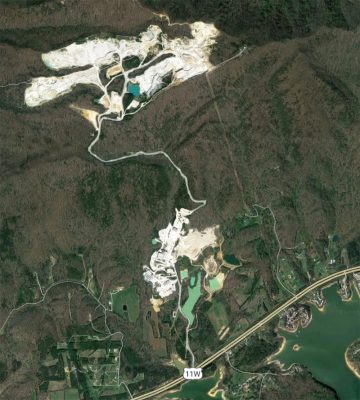Frac Sand Mining in Appalachia
By Ashley Goodman

An aerial view of Short Mountain Silica’s operation in Hawkins County, Tenn. Accessed via Google Maps, March 20, 2018
A step in oil and gas extraction that often goes unseen is the mining of frac sand, a necessary component in the fracking process.
Frac sand is a high-purity silica sand made from durable, rounded quartz grains. Silica sand mining is underway at quartz formations across the country.
In fracking, wells are drilled into oil-laden rock shales, and water laden with chemicals, thickeners and sand is pumped into the wells at high pressure, creating expansion and fractures in the rock.
This is where frac sand comes in. When the water flow stops, the cracks in the rock deflate and are propped open by millions of grains of frac sand. These porous cracks allow oil and gas to seep through the cracks and fill the wells.
Though frac sand mining is most common in quartz-rich regions like Wisconsin, areas across Appalachia are also home to frac sand mines.
The FracTracker Alliance, an organization that studies and communicates the risks of oil and gas development, estimates that almost 50 frac sand-related facilities operate in Kentucky, Maryland, North Carolina, Pennsylvania, Tennessee, Virginia and West Virginia.
One prominent frac sand mine in Appalachia is Short Mountain Silica Co., located in Mooresburg, Tenn. Short Mountain Silica is a quarry that spans 452 acres, according to its 2017 state water pollution permit.
According to its website, Short Mountain Silica has been mining and manufacturing silica products since 1988 and began producing frac sand in 2012.
Tony Poole works as chief engineer at the PBS WETP-TV tower, located on Short Mountain Silica Road. Poole estimates that the tower is a mere 600-700 feet from the mine.
In his seven years working at the tower, Poole says he has watched the mine grow. The mine has become increasingly close to the transmit tower, and he has seen expanses of forest disappear.
Poole has heard stories from coworkers about problems with the mine years ago. Explosives would unearth rock formations, which sent debris flying and damaged the nearby road, and dust and noise pollution was a much larger problem. According to Poole, his colleagues estimate that these issues were mostly resolved about 10 years ago.
What worries Poole today, however, is the habitat destruction the expanding mine has caused.
“There’s a lot of cougar or wildcats running around up there, and lots of deer up there, and you haven’t seen them in a few years,” Poole says. “Wildlife is just disappearing.”
Short Mountain Silica did not respond to requests for comment.
Related Articles
Latest News

Leave a comment
Your email address will not be published. Required fields are marked *
2 responses to “Frac Sand Mining in Appalachia”
-
Actually, if environmentally responsible means of mining high-purity silicon dioxide could be developed and deployed in Appalachia, this could go a long ways toward giving the left-behind families unemployed by the much more toxic and dying coal mining industry a new lease on prosperity. As a retired VA Physician, I despair of seeing another generation of young people join the ranks of the emphysemnatous lung-cancer patients I cared for over years in my East Tennessee VA clinics who were destroyed by working the coal mines. The chip industry that depends on has the potential to be a ready customer for gathering next half-century, at least. We should be looking at the potential for econologicallly-responsible means of helping this resource-extraction industry to benefit our Appalachian communities. And, no, I’m not a spokesperson for the mining industry and have eschewed investment in eco-destructive industries in my personal retirement plan.
-
Dear Ashley, Thank you for your article. I am a degreed petroleum engineer living in Appalachia (and practicing law). If you ever need a technical review of an article, I would be happy to help. Service companies have a voracious appetite for sand. From an engineering standpoint, as much sand as can be carried by the medium downhole without causing a screen-out is used. No sand ever returns to the surface or would ever contaminate an aquifer once it is pumped downhole. Sand does not pollute the air or kill wildlife during well completion. The greater danger is if an FRV is triggered at the surface, but that (almost) never happens.





Leave a Comment